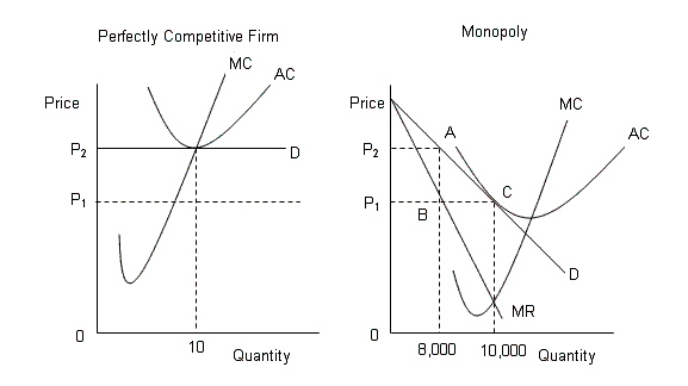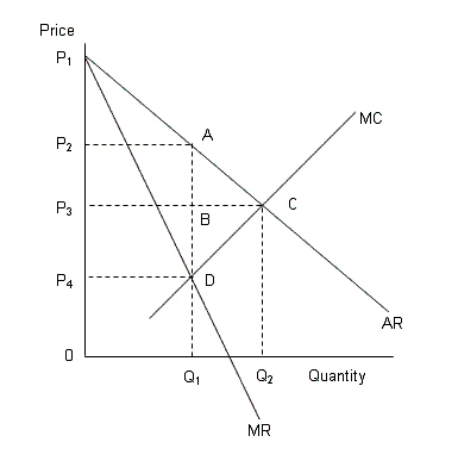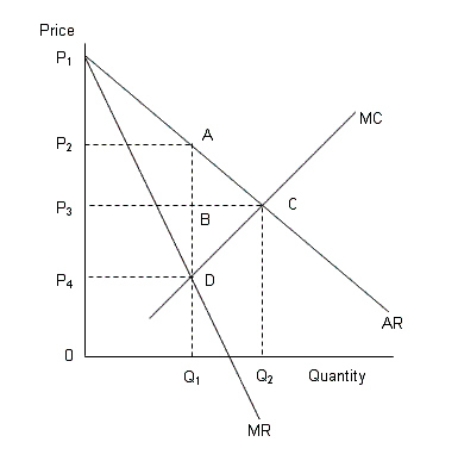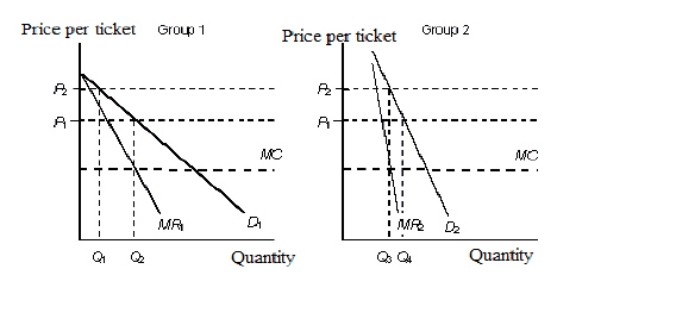B) False
Correct Answer

verified
Correct Answer
verified
Multiple Choice
If a firm has a perfectly elastic demand curve, then:
A) it must be a monopoly firm.
B) it can charge any price it desires.
C) the firm has significant market power.
D) the firm has no market power.
E) the firm should shut down.
G) B) and C)
Correct Answer

verified
Correct Answer
verified
Multiple Choice
The following figures show the demand and cost curves of a perfectly competitive and a monopoly firm respectively. Figure 24.7  D: Average Revenue
AC: Average cost
MC: Marginal cost
MR: Marginal cost
Calculate the deadweight loss in Figure 24.6, if the perfectly competitive industry is monopolized after it had been producing an output of 10, 000 units?
D: Average Revenue
AC: Average cost
MC: Marginal cost
MR: Marginal cost
Calculate the deadweight loss in Figure 24.6, if the perfectly competitive industry is monopolized after it had been producing an output of 10, 000 units?
A) The area P2ACP1
B) The area ABC
C) The area P2ABP1
D) The distance AB
E) There is no deadweight loss
G) A) and B)
Correct Answer

verified
Correct Answer
verified
True/False
If a firm is able to collect the entire producer surplus, it is said to have practiced perfect price discrimination.
B) False
Correct Answer

verified
Correct Answer
verified
Multiple Choice
If at an output of 10 units a monopolist is earning a positive profit, marginal revenue is $6, and marginal cost is $4, then the monopolist:
A) is in equilibrium.
B) should increase output.
C) should reduce output.
D) should lower the price at the current output level.
E) should raise the price at the current output level.
G) C) and E)
Correct Answer

verified
Correct Answer
verified
True/False
By discriminating between the consumers, the monopolist actually takes away a portion of the consumer surplus.
B) False
Correct Answer

verified
Correct Answer
verified
Multiple Choice
A clothing store can sell two shirts for $20 each or three shirts for $18 each.At a quantity of three shirts sold, marginal revenue is _____.
A) $18
B) $14
C) $54
D) $20
E) $44
G) A) and C)
Correct Answer

verified
Correct Answer
verified
Multiple Choice
Which of the following statements is true?
A) A perfectly competitive firm's demand curve is the market-demand curve.
B) For a monopolist, the demand curve faced by a monopolist is more elastic than the one faced by a competitive firm.
C) For a monopolist, the law of demand generally does not apply because it is the only firm in a market.
D) A monopolist's demand curve is the market-demand curve.
E) The demand curve faced by a monopolist is flatter than the market demand curve.
G) D) and E)
Correct Answer

verified
Correct Answer
verified
Multiple Choice
Which of the following is not a necessary condition for price discrimination?
A) The firm must be a price maker.
B) The firm must be able to distinguish between customers.
C) The firm must be able to prevent resale between customers.
D) The firm must be able to product homogenous products.
E) The firm must be facing a downward-sloping demand curve.
G) None of the above
Correct Answer

verified
Correct Answer
verified
Multiple Choice
Barriers to entry do not occur when:
A) economies of scale in production exist in an industry.
B) the government requires a professional license or franchise agreement.
C) the firm that introduces a product is granted a patent.
D) a firm controls a scarce resource.
E) diseconomies of scale in production exist in an industry.
G) B) and E)
Correct Answer

verified
Correct Answer
verified
Multiple Choice
The following figure shows revenue and cost curves of a monopolist. Figure 24.8  AR: Average revenue curve
MR: Marginal revenue curve
MC: Marginal cost curve
According to Figure 24.7, the profit maximizing price of the monopolist is:
AR: Average revenue curve
MR: Marginal revenue curve
MC: Marginal cost curve
According to Figure 24.7, the profit maximizing price of the monopolist is:
A) 0.
B) P4.
C) P3.
D) P2.
E) P1.
G) None of the above
Correct Answer

verified
Correct Answer
verified
True/False
A monopolist earns only normal profits in the long run.
B) False
Correct Answer

verified
Correct Answer
verified
Multiple Choice
Grocery store coupons, mail-in rebates, senior discounts, and in-state versus out-of-state tuition fees are all examples of:
A) government intervention.
B) price neutrality.
C) arbitrage pricing.
D) price discrimination.
E) illegal business practice.
G) A) and E)
Correct Answer

verified
Correct Answer
verified
Multiple Choice
The ability of a firm to charge different customers different prices is called _____:
A) price ceiling.
B) price discrimination.
C) predatory pricing.
D) price flooring.
E) basing point pricing.
G) None of the above
Correct Answer

verified
Correct Answer
verified
Multiple Choice
Perfect competition provides one model in which there are many firms with no barriers to entry.If perfect competition as a model lies on one extreme, the model that lies on the opposite extreme is:
A) monopolistic competition.
B) oligopoly.
C) monopoly.
D) imperfect competition.
E) oligopolistic competition.
G) D) and E)
Correct Answer

verified
Correct Answer
verified
Multiple Choice
The following table shows the marginal revenues earned by a price discriminating monopolist from two different markets. Table 24.4
 Refer to Table 24.4.If marginal cost is $30 in both markets, what quantities will be supplied in each of the markets?
Refer to Table 24.4.If marginal cost is $30 in both markets, what quantities will be supplied in each of the markets?
A) 4 units in market X;1 unit in market Y
B) 4 units in market X;2 units in market Y
C) 2 units in market X;3 units in market Y
D) 3 units in market X;3 units in market Y
E) 3 units in market X;nothing in market Y
G) A) and C)
Correct Answer

verified
Correct Answer
verified
Multiple Choice
The following figure shows revenue and cost curves of a monopolist. Figure 24.8  AR: Average revenue curve
MR: Marginal revenue curve
MC: Marginal cost curve
According to Figure 24.7, the deadweight loss of monopoly is:
AR: Average revenue curve
MR: Marginal revenue curve
MC: Marginal cost curve
According to Figure 24.7, the deadweight loss of monopoly is:
A) the area ABC.
B) the area BCD.
C) the area ACD.
D) the area P3P2AC.
E) the area P3P4DC.
G) A) and C)
Correct Answer

verified
Correct Answer
verified
Multiple Choice
The figure given below shows the demand curves of two classes of buyers for tickets to a football match. Figure 24.4  D1: Demand curve of group 1
D2: Demand curve of group 2
MR1: Marginal revenue of group 1
MR2: Marginal revenue of group 2
MC: Marginal cost
In Figure 24.4, the demand curve D2:
D1: Demand curve of group 1
D2: Demand curve of group 2
MR1: Marginal revenue of group 1
MR2: Marginal revenue of group 2
MC: Marginal cost
In Figure 24.4, the demand curve D2:
A) has a price elasticity of demand greater than 1.
B) is relatively less price elastic than D1.
C) is the inverse of the demand curve D1.
D) has a price elasticity of demand less than 1.
E) represents the demand of the group that is more responsive to price changes.
G) A) and B)
Correct Answer

verified
Correct Answer
verified
Showing 101 - 118 of 118
Related Exams